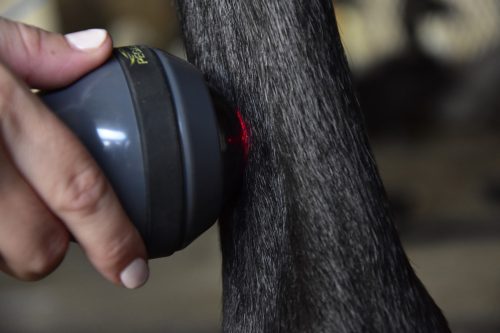Joint Therapies
We provide a range of on-site joint therapies. Most horses respond well to the standard therapy of intraarticular steroids and hyaluronic acid. These medications reduce pain and inflammation in the joint by temporarily stopping production of the molecules that cause inflammation and signal pain. Additionally, we have ProStride and Restigen PRP available. Both of these products are made from the horse’s own blood and use the body’s natural anti-inflammatory and healing factors. ProStride is very effective for treating joints with advanced arthritis or those that no longer respond well to steroid injections. PRP is frequently used to improve healing ligament and tendon injuries.
Stem cell treatment is also indicated in some cases. They can be used to stimulate healing in tendon and ligament injuries, as well as some OCD lesions. Stem cells can travel to and concentrate at injuries before moving on. They can be injected directly into an injury, or when that is not possible, given into a blood vessel nearby. However, stem cell harvest and culture must be done in a very clean and controlled environment, so we recommend starting the procedure at a referral facility.
Shockwave Therapy
Shockwave therapy is beneficial for treatment of orthopedic pain and tendon and ligament injuries. It works by stimulating cells with pressure or sound waves to produce growth factors and anti-inflammatory factors to improve or re-start healing. This is especially useful at bone-tendon or bone-ligament interfaces, like the proximal suspensory ligament. It is also potent orthopedic pain reliever and can be used to treat arthritis or other bone pain. Shockwave can be an excellent pain reducer, so we do not recommend and will not treat any horses within one week of high stress exercise, such as gallop training, racing, or jump work due to the risk of masking injuries and pain that could cause additional injury.
Laser Therapy
Laser therapy is now called “photobiomodulation,” but treatment with laser light has had many names before, like cold laser and low level light therapy. No matter the name, it works by reducing pain, increasing the metabolism of cells within 6 to 8cm of the skin surface, and increasing blood flow. Wounds and injuries heal better and faster when treated with a course of laser therapy. Class IIIb and Class IV lasers are the most commonly used lasers in veterinary medicine, and differ in the power output of the laser. We use a class IV Pegasus laser.

Mesotherapy
Mesotherapy is used to reduce pain along the neck and back with superficial injections into the deep layers of the skin. This blocks deeper pain signals, reducing soreness and muscle spasms. This can help stop chronic pain and aid in rehabilitation of proper biomechanics.

